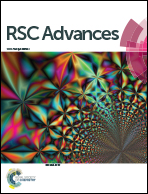Controlled thermal nitridation resulting in improved structural and photoelectrochemical properties from Ta3N5 nanotubular photoanodes†
Abstract
Ta3N5 nanotubular photoanodes were synthesized by thermal nitridation of anodized Ta2O5 nanotubes (NTs) in a temperature range from 650 °C to 1000 °C. XRD diffractograms and Rietveld refinements show that the crystalline structure is strongly dependent on thermal nitridation that triggers defects in the orthorhombic structure of Ta3N5 NTs. A non-stoichiometric TaN0.1 phase was observed at the bottom of the Ta3N5 NTs at the Ta–Ta3N5 interface. Electrochemical impedance spectroscopy revealed that nitridation conditions such as temperature and time strongly influence the interfacial charge transportation; affecting the photoelectrochemical (PEC) activities of the photoanodes. Improved PEC performance was obtained from the NTs synthesized at higher temperature for shorter nitridation time. This result is related to the preservation of the tubular morphology obtained at short nitridation time, high crystallinity and lower charge transfer resistance across the semiconductor–electrolyte interface.


 Please wait while we load your content...
Please wait while we load your content...